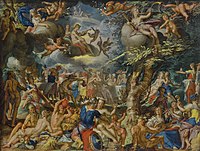Banquet
| Part of a series on |
| Meals |
|---|
 |
| Meals |
| Components and courses |
| Related concepts |

A banquet (/ˈbæŋkwɪt/; French: [bɑ̃kɛ]) is a formal large meal or feast,[1] where a number of people consume food together. Banquets are traditionally held to enhance the prestige of a host, or reinforce social bonds among joint contributors. Modern examples of these purposes include a charitable gathering, a ceremony, or a celebration. They often involve speeches in honor of the topic or guest of honour.[2]
Social meanings
Banquets feature luxury foods, often including animal meat.[3][4] Feasts can be divided into two fundamental types: solidarity (or alliance, or empowering) and promotional (or aggrandisive, competitive, or diacritical).[5][6][7] Solidarity feasts are a joint effort in which families or communities bring equivalent contributions together to reinforce the social ties of all concerned. Promotional feasts are intended to enhance the social status of the host, who provides the food in order to create obligations to themselves among the guests.[8]
Historical examples
Communal feasting is evidenced from the early Neolithic in Britain.[9] In Ancient Greece, symposia, formed a routine part of life involving the celebratory drinking of wine, conversation and performances of poetry and music.[10]
Notable historical and legendary examples of banquets include Belshazzar's Feast, Last Supper, Manchu Han Imperial Feast, and Mead halls.
A luau is one variety of traditional banquet originally used in Hawaii.
Many cultures have developed structures for banquets. In the European Middle Ages, comprehensive ritualised elements were involved in a traditional three-course menu, having up to 25 dishes in each course (this structure persisted into the 19th century). The structure was later altered to two courses, with the pre-existing third course changed to the serving of fruit and nuts.[11]
Banqueting rooms varied greatly with location, but tended to be on an intimate scale, either in a garden room, banquet hall or inside such as the small banqueting turrets in Longleat House.
Contemporary examples
Contemporary banquets serve many new purposes in addition to their traditional purposes. These can include anything from during workplace training sessions and formal business dinners to birthday parties and social gatherings. It is common for a banquet to be organized at the end of academic conferences. The basis of banquets is to make space available for a gathering of people. Hence forwards arises the need to accommodate, entertain and feed the attendees. Which in turn gives way to food, drinks, catering, servicing and some sort of recreational entertainment.[12]
Government involvement
The State Council of the People's Republic of China levied a tax on banquets on September 2nd 1988, at a tax rate calculated per occasion between 15% to 20% of the banquet's value.[13][14]
Banquets held over time
-
Hellenistic banquet scene
-
A banquet for Babur
-
A Chinese painting of an outdoor banquet, from the era of the Song dynasty (960–1279).
-
State Banquet. Serving the Peacock. Facsimile of a woodcut in an edition of Virgil, folio, published at Lyons in 1517.
-
Joachim Wtewael: Banquet of the Gods, around 1602
-
Chinese banquet for a birthday celebration
See also
References
- ^ "Banquet." (definition). Merriam-webster.com. Accessed August 2011.
- ^ "BANQUET | meaning in the Cambridge English Dictionary". dictionary.cambridge.org. Retrieved 2019-03-29.
- ^ Bendall, L. 2004: Fit for a King? Hierarchy, exclusion, aspiration and desire in the social structure of Mycenaean banqueting. In Halstead, P. and Barrett, J.C. (eds), Food, Cuisine and Society in Prehistoric Greece (Oxford, Sheffield Studies in Aegean Archaeology 5), 105–35.
- ^ Hayden, Brian (2003). "Were luxury foods the first domesticates? Ethnoarchaeological perspectives from Southeast Asia". World Archaeology. 34 (3): 458–469. doi:10.1080/0043824021000026459a. S2CID 162526285.
- ^ Hayden, B. 2001. Fabulous feasts: a prolegomenon to the importance of feasting. In M. Dietler & B. Hayden (eds), Feasts: Archaeological and ethnographic perspectives on food, politics, and power, 23–64. Washington, DC: Smithsonian Institution
- ^ Adams, R.L. 2004. An ethnoarchaeological study of feasting in Sulawesi, Indonesia. Journal of Anthropological Archaeology 23, 56–78
- ^ Rowley-Conwy, P. 2018. Zooarchaeology and the elusive feast: from performance to aftermath. World Archaeology 50(1), doi: 10.1080/00438243.00432018.01445024
- ^ Dietler, M. 2001. Theorizing the feast: rituals of consumption, commensal politics, and power in African societies. In M. Dietler & B. Hayden (eds), Feasts.Archaeological and Ethnographic Perspectives on Food,Politics, and Power, 65–114. Washington DC: Smithsonian Institution.
- ^ Gron, Kurt J.; Rowley-Conwy, Peter; Fernandez-Dominguez, Eva; Gröcke, Darren R.; Montgomery, Janet; Nowell, Geoff M.; Patterson, William P. (2018). "A Meeting in the Forest: Hunters and Farmers at the Coneybury 'Anomaly', Wiltshire". Proceedings of the Prehistoric Society. 84: 111–144. doi:10.1017/ppr.2018.15. ISSN 0079-497X.
- ^ Department of Greek and Roman Art. “The Symposium in Ancient Greece.” In Heilbrunn Timeline of Art History. New York: The Metropolitan Museum of Art, 2000–. http://www.metmuseum.org/toah/hd/symp/hd_symp.htm (October 2002)
- ^ Scanlon Loman, Nancy (2013). Catering management (4th ed.). Hoboken, N.J.: Wiley. ISBN 9781118091494. OCLC 774863928.
- ^ https://metroviewhotel.com/banquets.htm#working
- ^ "Provisional Regulations of the People's Republic of China on Banquet Tax - 1988". Lehman Law. Retrieved 30 October 2020.
{{cite web}}: CS1 maint: url-status (link) - ^ "Provisional Regulations of the People's Republic of China on Banquet Tax". Law Info China. Retrieved 30 October 2020.
{{cite web}}: CS1 maint: url-status (link)
Further reading
- Albala, Ken (2007). The banquet: Dining in the Great Courts of late Renaissance Europe. Board of Trustees, University of Illinois. ISBN 978-0-252-03133-5.






